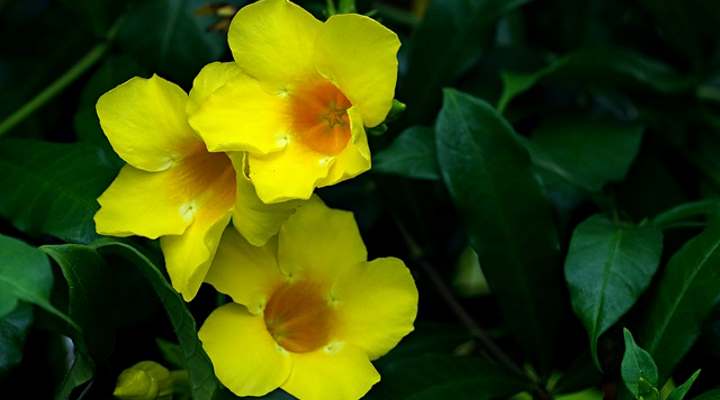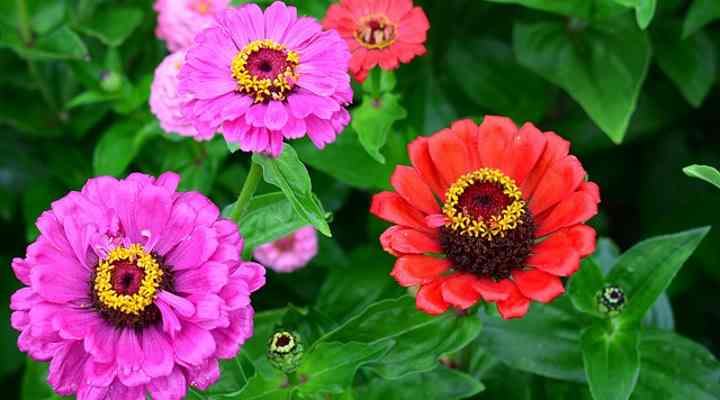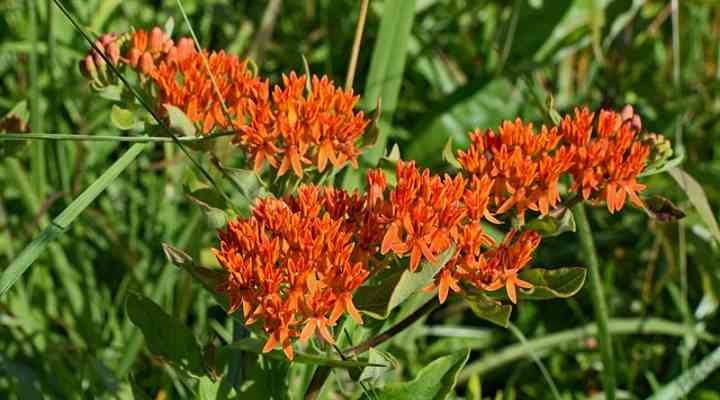Full Sun Florida Plants (Flowers, Shrubs) – Pictures and Identification

Growing full sun plants in your Florida garden will add color, texture, and floral aromas to your yard throughout the year. However, finding suitable plants that thrive in the Sunshine State’s warm, humid, and coastal climate can be challenging. Furthermore, it’s crucial to consider the difference between growing conditions from the hot tropical climate in southern Florida to the mild winters in northern Florida, where temperatures sometimes drop below freezing.
This article is a guide to identifying the best plants suitable for full sun exposure throughout Florida. You will also get handy landscaping tips on the best ways to use these beautiful plants in a Florida landscape.
The Best Full Sun Plants for Growing in Florida
Examples of the best full sun plants for Florida are hibiscus, black-eyed Susan, passion flower, milkweed, and viburnum. The best plants that tolerate full sun exposure in Florida are suitable for growing in USDA zones 9 through 11. In addition, many of these flowering plants will bloom in Florida throughout the year and tolerate some drought.
Growing Zones in Florida
There are four USDA growing zones in Florida — zones 8 through 11. These zones will affect which kinds of flowering plants you can plant in Florida gardens. For example, some evergreen Florida plants suitable for zones 10 and 11 may grow as tender perennials in zone 8.
Zone 8 is in North Florida. This zone includes Florida’s panhandle from Pensacola to Jacksonville and south to just above Orlando. It has a subtropical climate, with short, mild winter seasons and long hot summer seasons. The minimum winter temperature is 20°F (-6.6°C).
Zone 9 is Central Florida and includes cities like Orlando, Tampa, and Jacksonville. The climate is subtropical to tropical, with minimum winter temperatures around 25°F (-3.8°C).
Zone 10 includes most areas of Florida south of Lake Okeechobee. This growing zone includes Fort Myers and Naples on the Gulf Coast to Miami, Ft. Lauderdale, and West Palm Beach on the Atlantic coast. The minimum temperature in winter is 30°F to 35°F (-1.1°C – 1.7°C).
Zone 11 is the southernmost point of Florida and includes the Florida Keys. Here the temperature doesn’t drop below 40°F (4.4°C).
Full Sun Florida Plants (With Pictures and Names)
Are you looking for some plants to add a splash of color to your sunny yard in Florida? If so, here is a list of the top full-sun Florida plants. Most plants are easy to care for. But more importantly, they thrive in warm, humid conditions in the southeast.
Bougainvillea

Bougainvillea is a full sun Florida flowering vine that come in various colors and is drought tolerant
Bougainvillea is a sun-loving flowering shrub with thorny stems and colorful clusters of flower-like papery bracts. This ornamental vining plant for full sun has spectacular colors when blooming throughout the year. The fast-growing evergreen Florida shrub grows between 8 and 40 ft. (2.4 – 12 m) tall and up to 30 ft. (9 m) wide.
Bougainvillea thrives in full sun and tolerates humidity, drought, and salty air exceptionally well. This creeping, vining shrub is ideal for growing over a wall or arbor or planting as a specimen plant or mass planting.
Bougainvillea is ideal for planting in Florida’s growing zones 9 through 11.
Tropical Hibiscus (Hibiscus rosa-sinensis)

Tropical hibiscus is a sun-loving shrub with colorful large flowers that tolerate humidity and heat
Also called Hawaiian hibiscus or Chinese hibiscus, this bushy flowering plant for Florida gardens loves plenty of sunlight. The large evergreen tropical shrub grows 8 to 16 ft. (2.4 – 5 m) tall and has large, showy trumpet-shaped flowers. The five-petaled flowers measure 4” (10 cm) in diameter and bloom in red, white, orange, yellow, purple, and pink colors.
Hibiscus shrubs are ideal for sunny, humid climates. They thrive in tropical conditions, and the ornamental shrubs bloom throughout the year. You can plant the shrubs as an evergreen flowering hedge, privacy screen, or specimen plant.
Chinese hibiscus is suitable for planting in USDA zones 10 and 11.
Viburnum

Dwarf Walter’s viburnum obovatum is a low growing evergreen shrub with white flowers that is suitable for landscaping sunny Florida gardens
Viburnum shrubs are perfect for planting in sunny yards because they thrive in all zones in Florida. Viburnum shrubs are known for their huge, showy blooms with conical, domed, or ball-like clusters of flowers. The large white or pink blossoms can measure 2” – 6” (5 – 15 cm) across.
Species of viburnum shrubs adapted to Florida’s warm, sunny climate include Walter’s viburnum (Viburnum obovatum), Arrowwood viburnum (Viburnum dentatum), and Sweet viburnum (Viburnum odoratissimum).
You can grow these large ornamental shrubs in a sunny landscape as specimen plants or small flowering trees in Florida. Dwarf viburnum varieties are ideal as foundation plantings, shrub borders, or flowering screens.
Many viburnum species are suitable for growing in the southeast in USDA zones 8 through 10.
Beach Sunflower (Helianthus debilis)

Beach sunflower is a full sun low maintenance ground cover perennial that grows well in Florida coastal zones
Beach sunflower is a spreading low maintenance perennial plant ideal for planting in coastal areas, including hot, dry sites. The ornamental feature of these yellow plants is their larger sunflower-like blossoms with golden yellow petals and brown centers. The large, brightly-colored flowers grow 7” to 10” (17 – 25 cm) tall, and flower heads are 3” (7.5 cm) across.
Beach sunflowers spread quickly and will bloom throughout the year in Florida’s warmest zones. In northern Florida, the yellow-flowering plant blooms from spring until fall. The low-maintenance perennials grow well as full-sun ground cover and attract pollinators to coastal gardens.
Beach sunflowers are suitable for growing in USDA zones 8 through 10.
Black-Eyed Susan (Rudbeckia hirta)

Black-eyed Susan is an easy-care drought-tolerant flowering plant for full sun that tolerates Florida summer heat
Black-eyed Susan is an easy-to-grow native Florida plant with yellow flowers on tall stems. These eye-catching bright yellow daisy-like flowers bloom throughout summer until fall. The heat-loving, drought tolerant plants also thrive in coastal regions. The flowers grow 2 to 3 ft. (0.6 – 1 m) tall and 2 ft. (0.6 m) wide.
Black-eyed Susans are ideal low maintenance plants for a Florida landscape. These flowers thrive in all zones in the southeast and require little maintenance. You can grow the yellow-flowering plants in cottage gardens, mixed borders, or along a foundation line where they get at least six hours of sunshine daily.
Grow black-eyed Susans in USDA zones 3 through 10 in well-drained soil.
Allamanda Bush (Allamanda schottii)

Allamanda bushes are tropical flowering shrubs for full sun that add bright color to south Florida landscapes
Bush allamanda is an evergreen tropical shrub that blooms in full sun with masses of golden yellow flowers. The showy Amanda bush flowers are funnel-shaped and feature orange throats. These yellow flowers measure 2” (5 cm) across and stand out against the green leathery foliage.
Allamanda bush grows 3 to 4 ft. (1 – 1.2 m) tall and wide.
Allamanda bush thrives in full sun or light shade. You can grow the vigorous, fast-growing shrub as a specimen plant, flowering evergreen hedge, or accent shrub. During warm Florida summers, it’s crucial to keep the soil moist and its roots cool.
Bush allamanda is suitable for planting outdoors in USDA zones 10 and 11.
Butterfly Bush (Buddleia davidii)

Butterfly bushes grow best in full sun and well-draining slightly acidic soil and are suitable mainly for central and north Florida
Also called summer lilac, the butterfly bush is a sun-loving ornamental purple-flowering shrub suitable for growing in central and northern Florida. Butterfly bush produces large cone-shaped arching clusters of fragrant purple blooms and semi-evergreen leaves. The purple conical flowers grow 8” (20 cm) long and cover the shrub during summer.
Butterfly bush grows 3 to 5 ft. (1 – 1.5 m) tall and wide. Growing in full sun, the drought-tolerant plant is an ideal foundation planting, shrub border, or container plant. The fragrant, long-lasting flowers also make for excellent cut flowers and dried floral displays.
Varieties of butterfly bush thrive in USDA zones 5 to 9. In southern Florida, dwarf varieties of Buddleja davidii like ‘Blue Heaven’ and ‘Tutti Fruitti Pink’ are suitable for zone 10.
Cape Jasmine (Gardenia jasminoides)

The white flowers of cape jasmine bush add beauty and fragrance to sunny Florida landscapes
Cape Jasmine is a native Florida plant known for its pure, bright white, intensely fragrant flowers and large dark glossy green leaves. The mounding evergreen shrub performs best in full sun with some afternoon shade in Florida’s hottest regions. The compact, spreading shrubs grow between 2 and 8 ft. (0.6 – 2.4 m) tall, depending on the cultivar.
Cape jasmine is an ideal white-flowering shrub for tropical landscapes. Many of the plants have showy double flowers growing in a rosette pattern. Other cape jasmine varieties have six-petalled, flat-faced single flowers. In a front or backyard, cape jasmine is ideal as a hedge, specimen plant, or container plant.
Cape jasmine shrubs are suitable for growing in USDA zones 8 to 11. However, there are some cold-hardier varieties for zones 6 and 7.
Blue Daze (Evolvulus)

Blue daze is a flowering perennial that can be grown in Florida as a ground cover plant for full sun
Blue daze is a ground-hugging herbaceous perennial that blooms with bright purple-blue flowers from spring until fall. This clumping, spreading plant is identified by its green, velvety leaves, small blue flowers, and low growth. This sun-loving ground cover plant grows 1.5 ft. (0.45 m) tall and up to 3 ft. (1 m) wide.
Blue daze is ideal for planting as ground cover in Florida landscapes. The mat-forming plant forms a carpet of fuzzy green foliage that contrasts with the blue flowers during the warm seasons. Due to its trailing nature, blue daze is also ideal as a hanging basket plant.
Blue daze is suitable for mass planting in all Florida areas in USDA zones 8 to 11.
Egyptian Star Flower (Pentas lanceolata)

Egyptian star flowers are low growing perennial plants for south Florida that grow best in full sun
Egyptian star flower is a tropical small pink-flowering shrub for Florida gardens that thrives in full sunlight. The best ornamental feature of the heat-loving shrub is its showy rounded clusters of star-shaped pink flowers that bloom throughout the year. These attractive pink blossoms contrast with the bright green foliage consisting of pointed leaves.
Although it tolerates some shade, the Egyptian star flower performs best in at least six hours of sunlight daily. The low-growing, mounding shrub sits well in beds and borders, planted along a foundation line, or growing in containers.
Growing in the ground in tropical landscapes, Egyptian star flowers thrive in USDA zones 10 and 11.
Canna Lily (Canna indica)

Canna lily grows best in full sun and adds colorful blooms and decorative foliage to Florida gardens
Canna lilies are heat-loving tropical perennial bulbs that add vibrant color and foliage to Florida gardens. Canna lily flowers bloom in shades of orange, red, pink, and yellow. When not flowering, the bulbous plants add texture to gardens with their lush, glossy green banana-shaped leaves. The eye-catching plants grow 2 to 3 ft. (0.6 – 1 m) tall.
Canna lilies look best when grown en masse along walls, borders, or hedges. The colorful floral displays of iris-like flowers on upright stalks grace gardens when blooming from mid-summer until fall.
Canna lilies are suitable for planting outdoors throughout the year in USDA zones 8 through 11.
Gerbera Daisies (Gerbera garvinea)

The bright cheerful colors of gerbera daisy make it a great choice for sunny front or backyards in Florida
Gerbera daisies produce large, showy flowers and are ideal for adding a pop of color to any garden in Florida. The characteristic gerbera flowers grow as a rosette of elongated colorful petals surrounding a disc center. The sun-loving blooms blossom from spring until the first frost but flower even longer in warmer climates.
Gerbera daisies are large disc-shaped flowers measuring 2” (5 cm) across, sitting on 18” (45 cm) tall stems. The cheerful flowers add plenty of pastel shades of pink, orange, peach, and red to the front of beds or borders.
Gerbera daisies thrive in full or partial sun in USDA zones 7 through 10.
Common Zinnia (Zinnia elegans)

Zinnias are sun-loving annuals in colder areas but grow as perennials in Florida and produce beautiful colorful blooms
Zinnia flowers are popular low maintenance plants in gardens throughout Florida due to their large pom-pom colorful flowers. The large flower heads come in all colors except blue. Zinnia flowers look like dahlias and can measure up to 6” (15 cm) across. The easy-to-grow landscaping plants have a long blooming season and rebloom if you deadhead them.
Zinnia plants produce striking flowers in full sun. The plants form a compact mound of green foliage with flowers blooming on the ends of long stems. They are terrific for planting in sunny beds and borders, along a property foundation, or growing in containers.
Grow zinnias outdoors in USDA zones 2 through 11. Zinnias grow as annuals in colder zones, but they are hardy flowering perennials in Florida.
Blanket Flower (Gaillardia)

The ornamental blanket flowers thrive in full sun and give a bright focal point to Florida gardens
Blanket flowers are perennials that produce brightly colored flowers growing at the end of long stems. The flower heads typically have yellow-tipped orange petals with a red and yellow center. However, some plants have double flowers with showy yellow blooms. Blanket flowers grow 2” to 3” (5 – 7.5 cm) wide and up to 3 ft. (1 m) tall.
Grow blanket flowers as an accent or mass plantings in all growing zones in Florida.
Blazing Star (Liatris)

Liatris spicata (gayfeather or blazing star) flowers thrive in full sun and can withstand some partial shade in hot and dry summer
Blazing star is an eye-catching plant for Florida gardens due to its tall flowering purple spikes. Blazing star plants are characterized by their grass-like foliage and lilac to purple bottlebrush flowers. These flowering spikes can reach 5 ft. (1.5 m) tall and add a strong vertical accent in sunny landscapes.
Blazing star is native to the southeastern United States and performs well in USDA zones 3 through 10.
Milkweed (Asclepias)

Asclepias tuberosa (in the picture) is a drought-tolerant full-sun flowering perennial that attract pollinators such as butterflies, honey bees, and other insects
Milkweed is a native plant, some species of which are endemic (only found) in Florida. Milkweed plants bloom with clusters of eye-catching red, orange, white, yellow, and pink flowers. The showy flowers typically grow at the ends of long stems and contrast with the plant’s slender green leaves.
Milkweed plants grow 2 to 3 ft. (0.6 – 1 m) tall and thrive in full sun. They have a long blooming season and will thrive throughout the year in USDA zones 9 to 11.
Passion Flower (Passiflora)

Passiflora is a full sun flowering vine with stunning purple flowers
Passion flower is a native perennial vine that blooms throughout all regions of Florida. The unusual exotic purple flowers are characterized by large petals covered with spidery filaments. The center of the flower is a large disc-corona and showy stamens. Passionflower vining plants grow 10 to 15 ft. (3 – 5 m) long.
Passion flowers are ideal for growing in tropical and subtropical gardens and are perfect for growing on trellises, fences, arbors, and over walls. Passion flowers thrive in USDA zones 7 through 11.
Tickseed (Coreopsis)

Tickseeds are hardy drought tolerant flowers for full sun that are common in Florida
Tickseed is a low maintenance plant with bright sunny yellow, red, or orange flowers that bloom in Florida from early summer until mid-fall. The easy-to-grow perennial grows as leafy mounds around 20” (50 cm) tall. Sun-loving flowering tickseed plants thrive in poor soils and are drought tolerant. The cheerful plant is ideal for mass plantings, beds and borders or growing in containers.
Tickseed is suitable for USDA zones 5 to 10.
Coontie (Zamia integrifolia)

Coontie cycad can be grown in both full sun and shaded locations and provides a focal point with its attractive foliage
Coontie is a type of shrubby cycad that is native to Florida. The clumping plant is identified by its leathery compound foliage that grows 10” to 50” (25 – 127 cm) long. The pinnately compound leaves can have up to 30 leaflets. The fern-like plant with its feathery foliage has excellent salt and drought tolerance.
Grow coontie cycads throughout Florida as evergreen ground cover plant or foundation planting. The shrub-like cycad thrives in the sun or shade and is hardy growing in zones 8 through 11.
Related articles:
- Florida Shrubs (Flowering, Evergreen, Vines)
- Florida Flowers (Native and Non-Native)
- Best Flowering Trees in Florida
